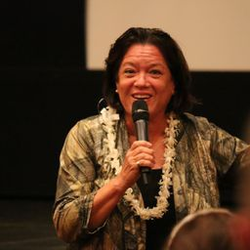 Filmmaker Meleanna Meyer
Filmmaker Meleanna Meyer The first of seven films, Meleanna Meyer’s Ho`oku`ikahi, (To Unify as One) was shown at Kahilu Theater on Wednesday, September 24th. It’s probably safe to say that nowhere in the world has an indigenous culture been so suppressed and yet returned to life so strongly. The culture lived on in the elders, a force of nature waiting for the right conditions to spring to life, manifesting Hōkūle`a and the beginning of the Hawaiian Cultural Renaissance. Quietly in many pockets throughout the islands, cultural and spiritual practices were brought to life and light as cultural practitioners such as Sam Ka`ai from Maui called young Hawaiians once again, “To throw and catch the spears of life.” Then in 1991, two hundred years and seven generations after the completion of Pu`ukohola Heiau by King Kamehameha I, came the day that, in the words of attendee Fred Cachola, who was present at Wednesday’s showing, “Hawaiians became Hawaiian. This event was a turning point. We’re going to stand up. We’re going to be there. We’re going to be Hawaiian.”
 Lanakila Mangauil
Lanakila Mangauil Filmmaker Meyer strolled among the audience at Wednesday’s showing, introducing herself, including everyone in her circle of Aloha. She doesn’t consider herself a filmmaker, just someone who answered the call of the pū (conch shell), the beat of the pa`u (ceremonial drum). She was in the gathering when Sam Ka`ai, (included in the film) revealed their kuleana to a group of young Hawaiians saying, “It’s really important that we renew ourselves in the seventh generation because the lord makani is waiting to blow away your memories. The lord of the wind is going to erase everything you hold dear at the eighth generation. And who are you? You are the eighth generation. You have been eating from the buffet of the world and neglect the plate of your `ohana.” Meyer was, “Horrified. It kept me up at night and compelled me to do the work. I was terrified but [realized that] all of us need to have the courage to step forward. We’re all in this together.” The final film was created from about fourteen days of filming from 1991 to 1998 with seven cameras rolling.
A voice rang out in chant from the back of the auditorium at the end of the question / comment session and Lanakila Mangauil, a young Hawaiian cultural practitioner, stood tall and commented, “I remember as a young boy being moved by it (Ho`oku`ikahi). They [elders] encouraged me to come back the next year and it instilled [a sense of] kuleana to come back to the heiau every year.” There were many other stories and remembrances that evening and in this way, the Kūkulu Ola Hawaiian Filmmakers festival offers a golden opportunity to share in the stories that weave together the rich culture and history that is Hawai`i.
 RSS Feed
RSS Feed
